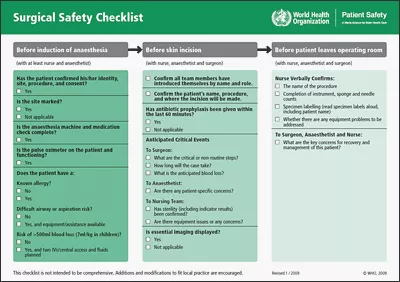
Surgical checklists have become essential over the last 20-odd years since their power of checklist has been proven by research. The evidence of their benefit is strong enough that there are now national and international uses to reduce human error, prevent mistakes and document hospital procedures’ best practices.
A surgical checklist has been shown to reduce complications and mortality in surgeries of any kind, including outpatient procedures.
Surgical Safety Checklist History
After results carried out by Atul Gawande, an American surgeon and public health researcher was published in the checklist manifesto, which explored the use of checklists in many industries, including the medical industry.
In 2000, the WHO published the first surgical safety checklist in the World Health Organization Journal. The checklist’s purpose was to ensure that the necessary actions were performed before, during, and after surgery. It was designed by a group of experts in the field of surgery, including Atul Gawande.
A checklist is a document that consists of a list of steps or tasks to be followed in order to perform a specific procedure. Checklists have been used in the aviation industry for many years with the Pre flight checklist. However, it was not until the 1970s that the aviation checklist started to be used in the medical industry. A checklist is an important part of any surgical process.
What is the surgical checklist?
With approximately a staggering 313 million surgical procedures performed annually (2020), worldwide surgical safety has to be addressed.
The World Health Organization (WHO) surgical safety checklist was developed to reduce the number of preventable deaths during surgery and improve recovery. The WHO surgical checklist was designed to help ensure that all necessary items were checked before starting a surgical procedure, during surgery and again after wound closure and aftercare following a clear checklist. It can be used in any surgical or medical procedure.
The main purpose of these checklists is to improve the safety of patients undergoing surgical procedures. The list contains a set of items that need to be checked before any surgery begins. The list should be used as a guide to ensure that all necessary items have been completed prior to the surgical procedure.
The checklists are designed for the entire team involved in the operation, not just the surgeons or nurses, but the whole surgical team. The checklists include an explanation of what each item is for and how it is to be performed.
Before any operation begins, it is important to make sure that you have everything you need for the procedure.
The UK’s National Health Service (NHS) has embraced surgical checklists and even expanded the original WHO surgical checklist.
What is the importance of surgical saftey checklist?
Surgical safety checklists are designed to reduce the number of preventable deaths during surgery and improve recovery. The WHO surgical checklist was designed to help ensure that all necessary items were checked before starting a surgical procedure, during surgery and again after wound closure and aftercare.
There are three main reasons why surgical checklists are so important:
- The WHO checklist includes a set of items which need to be checked before any surgery begins. The list should be used as a guide to ensure that all necessary items have been completed prior to the surgical procedure.
- The list helps to ensure that there is no confusion about who is performing what task during the surgical procedure. This is especially important when there are multiple teams working together in the operating theatre.
- The checklist is designed to encourage all members of the surgical team to follow the same procedures, making it easier for them to work together to achieve the best outcome.
Why checklists are important and how checklists can save lives.
How does a surgical checklist work?
Before starting the surgical procedure, the surgeon or team should check that all the required items are available. They should also check that all necessary equipment has been prepared and brought into the operating theatre.
For example, the anaesthetist may be responsible for checking that the patient has been prepped and draped properly, the correct size of the intravenous cannula has been placed, and the patient is breathing adequately.
What is the advantage of using the WHO surgical checklist?
The main advantage of using the WHO checklist is that it is designed to ensure that the patient’s safety is considered throughout the surgical process. The checklist ensures that all necessary items have been completed prior to the surgical procedure. This is because if something is missed, then the patient’s safety could be at risk. This is especially important when there are multiple teams working together in the operating theatre.
How many items are included in the WHO Surgical Safety Checklist?
What is the WHO Surgical checklist? The World Health Organization (WHO) released their ‘Surgical checklist’ back in May 2016. It is a simple checklist that has been proven to reduce death from surgical complications by 22% and reduce surgical infections by 24%.
The WHO surgical checklist is a 19-item checklist and has recently been updated

How effective is the WHO Surgical checklist?
This has been debated and researched an awful lot. There are good articles and research papers on it, some bad ones, and a couple that are both.
It seems like everyone is for or against it. I’m going to try to address the arguments against it and show why it may be more effective than you think.
The British Medical Journal (BMJ) Medical and surgical checklists can help reduce mortality and morbidity but only based on how well it’s being implemented
A research paper on PubMed studied a total of 3638 patients over a four-year period on how effective the surgical checklist was in reducing complications and final outcomes of patients. The research paper concluded, “WHO SSC (surgical safety Checklist) is an effective tool in reducing in-hospital complications thus producing a favourable outcome.“
Yet another research paper on Pubmed concluded in their study
The Effect of the WHO Surgical Safety Checklist
One of the most interesting research papers looked into the Impact of the WHO Surgical Safety Checklist, had largely positive results and concluded.
The WHO SSC positively impacts the things it was explicitly designed to address and does not positively impact things it was not explicitly designed for.
Impact of the WHO Surgical Safety Checklist Relative to Its Design and Intended Use: A Systematic Review and Meta-Meta-Analysis
Surgical Errors Statistics 2020
Surgical errors and medical errors cause approximately 250,000 deaths in the United States every year.
The EU believes that they can prove medical errors of 50% to 70.2% can be prevented through a comprehensive and systematic approach to patient safety.